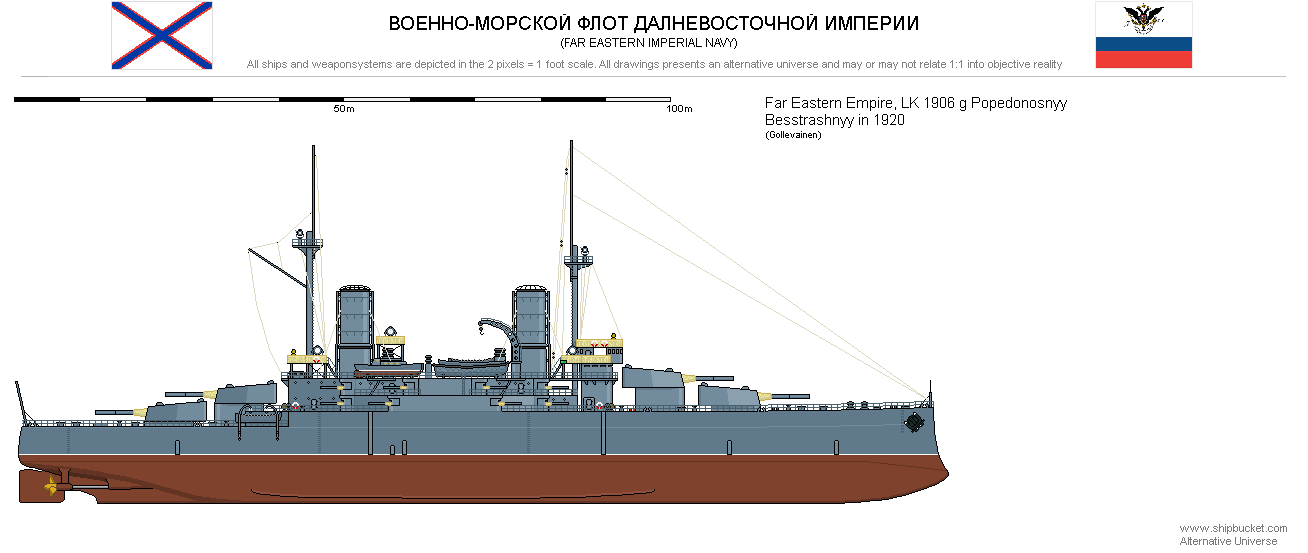LK 1906 Popedonosnyy class Battleship
| Popedonosnyy class Battleship | |
|---|---|
| Class overview | |
| Name | Popedonosnyy class Battleship |
| Operators | Far Eastern Imperial Navy |
| Class before | Slavnyy class Battleship |
| Planned | 2 |
| Built | 2 |
| General Characteristics | |
| Type | Battleship |
| Displacement |
|
| Length | 141.88 metres (465.5 ft) |
| Beam | 24.4 metres (80 ft) |
| Draught | 8.5 metres (28 ft) |
| Propulsion | 2 shafts, 2 VTE steam engines |
| Power |
|
| Speed | 18,5 kts |
| Range | 6900 nm at 10 kts |
| Complement | 950 |
| Armament |
|
| Armour |
|
Development
Popedonosnyy class were ordered before the war initially as a scaled-up version of the Slavnyy class. They were to be Far Eastern awnser to Japanese Kashima class battleships with secondary caliber icreased to 254mm. However the order was cut by the war and in the aftermath canceled. After the war a "Special committee of readjustment in naval affairs" was set up to analyze the war experience and result of the Far Eastern defeat. It was decided that the new battleships despite in great need for replenishing the fleet were to feature all cruisal experiences which the new committee would recommend for battleships.
One of the most important relevation was need of uniformal "all big gun" arrangement of main caliber guns. This concept was also been adopted abroad specially in UK which laid down the first of such battleships, the HMS Dreadnought. Second major new design feature, which remained unique to Far Eastern battleships were the maximum armor concept where the complete exposed hullside were to be armored even if it ment that the thicknes of the main belt armor would be lower than in contemporary designs. This was due the experience in the 1904 and 1905 battles of Tsusima where the unarmored ends of battleships received damage which in several cases were fatal for the whole ship and none of the Far Eastern battleships had their main belts penetrated by the japanese shells.
With these new concepts, order for two new battleships were hurried based loosely on the pre-war design. It had 8 305mm guns fitted in 4 turrets centerline with superfiring pairs in fore and end of the ship. The arragment of the main guns were similar to the US South Carolina class beign built at the same time. All small caliber guns were deleted and instead 16 120mm anti-torpedoboat guns were fitted in casemates alongside the superstructure. This unsual placement of the guns were result on another protective meassure. The hullside was ment to kept entirely clean without any breaks of port holes or casemates in case of the ship developing list that could cause flooding. This made the ships ventilation rather difficult and it was reportedly uninhabitable in tropical waters.
Two ships were build which became the first "dreadnought" or "Post-Tsusima" class battleships in Far Eastern service. They had unlike their British equivalent old triple-expansion steam engines instead of steam turbines giving them severe handicap in speed compared to other Dreadnoughts.
Ships in class
| Name | Builder | Laid down | Launch Date | Entered Service | Fate |
|---|---|---|---|---|---|
| Popedonosnyy | Voenno-Morskoy verf, Dalny | May 1907 | August 1908 | February 1910 | Extant in 1920 |
| Besstashnyy | Admiralteyskiye verf, Vladivostok | June 1907 | November 1908 | April 1910 | Extant in 1920 |
